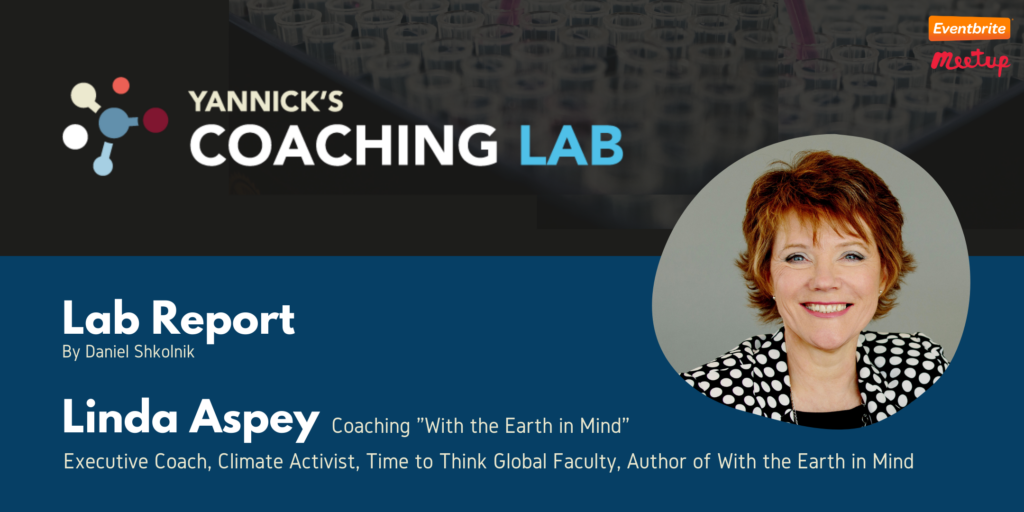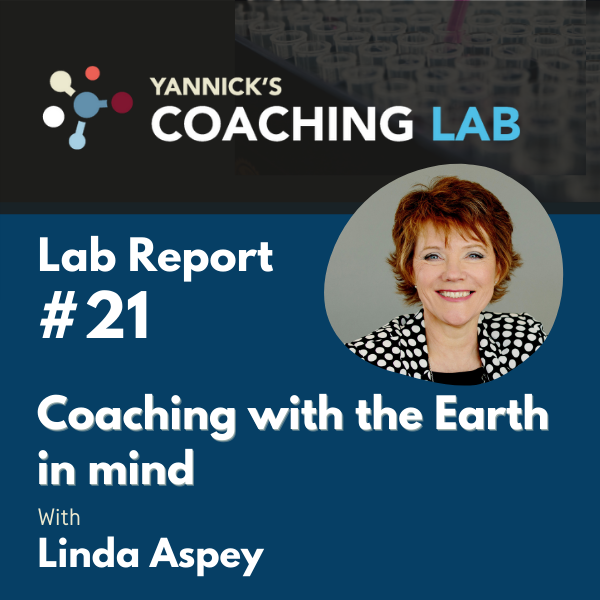
Linda created a thinking environment and only spoke 3 times during this session. I personally found it very inspiring to see Nancy Kline’s approach delivered with such professionalism, though there were also voices that questioned whether this session could have been more effective if the coach had been more active. Fascinating!
Curious to know more? Have a peek at this month’s Lab Report below or consider membership to access the recording of this and many more exciting coaching sessions (including a 45min debrief and Q&A with coach and client).
Yannick’s Coaching Lab #21 — Linda Aspey
Lab Report by Daniel Lev Shkolnik
Summary
Linda Aspey coached Thomas who presented concerned about burnout, anxiety, and discouragement of working on climate policy and activism. Perhaps the most striking thing about Aspey’s coaching style was its minimalism. Throughout the coaching session, she asked Thomas only three questions. The rest of the time, she simply held a “thinking environment” for Thomas.
Thinking Environment — Aspey relied extensively on the “Thinking Environment” model developed by Nancy Kline (https://www.aspey.com/time-to-think) where, instead of dominating or even leading the conversation, the coach creates a “thinking environment” for the client in which they are allowed to explore their issues and make stream-of-consciousness connections and realizations. This model of coaching puts the client completely in control of the session.
Aspey contracted briefly with Thomas at the start of the session so that he knew what to expect, how to ask for questions from her, and what to do if the silence became unhelpful. Aspey made a promise never to interrupt her client, and she proceeded to listen intently and to hold space for Thomas.
Coaching with the Earth in Mind — In preparation for the session Thomas had been sent a graphic that Aspey developed (http://www.withearthinmind.org/) and which was the anchor for much of the coaching session. When invited for guidance, Aspey simply invited Thomas to return to the model, asking “what else are you drawn to?”, which prompted Thomas to continue his thinking.
Key moments from the session:
- Wabi-sabi: reflecting on this Japanese concept that everything is imperfect reminded Thomas to “take a step back and observe, appreciate more, as opposed to being there in the intensity of the emotions.”
- Gratitude: Thomas re-framed the difficulty of his work through a lense of gratitude: “I’m grateful that I am able to make a difference.”
- Keeping the heart open: Thomas reflected on how important it is “not to let yourself be consumed by the hatred for those you might be up against.”
- The power of holding space: Linda held space and rarely spoke. She held silences powerfully.
Takeaways
Thinking environments may work in mysterious ways — After the session, many coaches attending the Lab wondered if this style of coaching was effective. From the outside, it didn’t look as though Aspey was doing much “coaching.” However, this coaching style trusts and relies on a client’s inner resources. The coach releases control over the session and instead provides caring and compassionate attention to the client. The silences force the client to provide their own answers instead of relying on the coach for solutions. At times, it seemed as though the session lacked focus and direction. However, as the session drew to a close, Thomas reflected: “I’ve expressed things in a wider context then I’ve done in a long time. Maybe ever.” While it felt as though there was more work for Thomas to do around finding answers to his core questions about managing burnout in climate change activism, Aspey, whose sessions are typically 90mins, had offered Thomas an additional 45min to follow up on and continue his thinking and Thomas reported that this had been a most helpful experience to him.
Resources and further reading: https://bit.ly/lab21resources
Watch the recording of this session and debrief by becoming a member: https://bit.ly/CoachingLabMembership
The complete vault of recordings can be found at https://bit.ly/LabRecordings
Many more exciting Labs are on the horizon: https://bit.ly/FutureCoachingLabs

